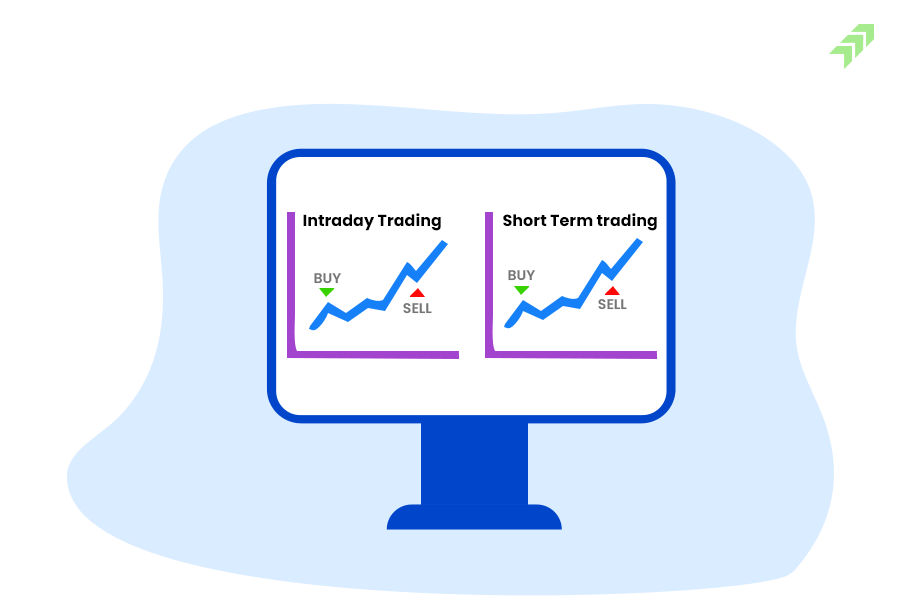Introduction
Volatility is the basic inherent property of stock market and to make best of it every investor or trader requires informed and wise decisions. For this purpose it is essential for traders to have a strong understanding and knowledge of the various trading methods and techniques along with their repercussions to minimize losses. In a normal trading activity, Short-term trading and intraday trading are two examples of popular trading strategies, each of which presents its own exclusive set of opportunities and challenges. This all-inclusive blog will research into the specifics of these strategies, assessing a variety of topics including taxation, ideas, and essential strategies, amongst other things. Regardless of whether you are a beginner or an experienced trader, this blog will offer you with very important information that will surely help you to figure out and successfully find the way in the world of intraday trading and short term trading.
Understanding short term trading
Any trader who involves in the process of buying and selling stocks during a period of time that is measured to be fairly short is generally referred as short term trading. In this trading technique, traders maintain their positions for a period ranging from a few days to a few weeks. Technical analysis is the key source behind any short term trading activity, which needs traders to review charts and indicators in order to mark patterns of price fluctuation, trends and volume analysis. Traders must be proficient and well averred of latest tools in this kind of trading so that they can generate good quantum of profits by reading various charts patterns that are only transient in nature.
Also read: How to Find Trending Stocks for Intraday Trading
There are several advantages and merits to trading on a short-term basis. Obviously every trader prime target is the opportunity to make money in a short amount of time. Taking advantage of the volatility of the market instead of daily both sides fluctuations and engaging in frequent trades are two strategies that traders can use to generate cash for themselves financially. With that being said, in order to keep up and pace the market volatility with a consistent market monitoring practice, it requires a significant amount of time and effort.
To generate maximum returns in short-term trading, every trader should requires a well defined trading plan that is disciplined coupled with strategy for risk management, and entry and exit points that are pre decided. Moreover unexpected market news and events plays a significant role and also it is not in control short term traders should have a exit plan in case of any negative outcome.
Also read: Maximize Your Profits: Discover the Benefits of Low Brokerage Option Trading
Exploring intraday trading
Intraday trading, often known as day trading, involves trading activities inside the same trading day. This type of trading is an alternative to short term trading. In this technique, buying and selling are simply considered to take place on the same day generally referred as Intraday Trading. Intraday trading is based on market movements and analysis of minute price movement’s i.e. 5 minutes15 minutes, 30 minutes etc during the course of the trading day. This is in contrast to trading that takes place over a shorter time period or for few days.
Also read: What is Intraday Trading: Is it Profitable, How to Learn & Earn Money
Intraday traders using their skills and speculation traded in index, options and stocks and closed their positions on the same day so there is no carry forward of trades. For intraday trading every trader who can synchronizes its trading with fast-paced atmosphere, ready to take up and down challenges and who have the time to sit in front of screen for long hours coupled with dedication skills to closely monitor the market movements throughout the day, only attract handsome returns. So this trading technique is not for everyone specially a big no for beginners.
Extremely sound knowledge of Technical analysis including complete understanding of various charts patterns is basis requirement in order to use trading opportunities as opportunities in intraday trading won’t last longer. This is the basic requirement to generate returns in intraday trading. Moreover a disciplined approach to risk management is required by traders, and this strategy includes the creation of tight stop-loss orders in order to limit the possibility of losses. Traders who are well averse in this technique could generate handsome returns on daily basis.
Next, we will delve deeper into the differences between short term trading and intraday trading, discussing factors such as time frame, trading style, and potential risks. It’s a comprehensive understanding of these trading strategies and their suitability for serious investors.
Key differences between short term and intraday trading
Even though both short-term trading and intraday trading have same properties to earn profits in n a short span of time, if we look precisely we found a huge difference in the two most common trading techniques. As we all know that these two techniques-Intraday and short terms are mostly used by general traders in each part of world so it is utmost important to understand the difference between the same to decide which one to select. Some basic and important points of differences are as under-
- Time frame: Intraday trading is all about buy and sell or you can say finishing trades within a single trading day means no carry forward of trades. On the other hand short-term trading carries forward trades from a few weeks to a few months. So it is very clear that short-term traders are more concerned in big price movement that usually take place in a longer version of time, whereas intraday traders are more focused in a single day price movements. They don’t want to carry trades even for the next day. So whether their trades are in losses or in profits intraday traders won’t carry their positions and square off on intraday basis. Moreover both techniques require special knowledge and skills of technical analysis but to apply on different time parameters is the main course of distinctions.
- Trading style: Every trader wants to generate best ROI on his capital. So in a broader sense or you can say in the best possible safe environment, short term trading could be the most preferred choice for on the account of its broader time frame, detailed and in depth use of technical analysis. On the other hand, intraday trading is more of riskier version of short term trading which involves the utilization of indicators and chart patterns too but limited to some extent.
- The possible dangers: As short term traders carry their positions to some days or some weeks, it is quite obvious that they are more exposed to the volatility of market. Any change in global or domestic scenario would definitely create an impact on their portfolio. Intraday traders are more vulnerable to the unpredictability of the intraday market as they are forced to take decisions on the basis of intraday movements. This speedy response might result in slippage or delays in execution.
Also read: What is Implied Volatility & Why it is importance in Trading
So overall both intraday and short term have likes and dislikes as per their inherit properties. Actually it depends of traders what kind of mind set they have, what are their risk taking capabilities. But one thing is very clear that intraday traders are required to have different mindset or to be more precise a quick and sharp response is badly needed to cater wild price movements. But short term traders have an advantage of longer time frame in respect of volatility.
Pros and cons of short term trading
Pros: Actually short term traders who have a longer time horizon have multiple benefits. Most important is the profit outcome probability which is much higher as trades are carried over a large span of time resulted large price movements. Generally short-term traders analyzed market trends on the basis of some technical analysis and chart patterns. If their view matched with the direction of market over a certain period of time their gaining percentages rises very sharply. Apart from this short-term trading provides various opportunities to traders to take advantage of in depth fundamental analysis i.e. analyzing financial statements, company news, and economic indicators resulted in a more inform decision and more returns. Subsequently in-depth knowledge of financial reports strengthens the decision making aspects of traders to select inexpensive equities.
Also read: Swing Trading Strategies Indicators & Best Stocks
Cons: There are some major flaws and concern with short term trading. Biggest risk is carrying positions over nightly. It can create a serious cause of concerns as trader’s positions are open to risk associated with global news. Any negative outcome will create gap down or gap up opening leads to sharp decline in portfolio. Furthermore, short term trading needs more commitment in terms of time and efforts. Traders need to monitor and rebalance their positions regularly and such efforts require lot of time to study, analyze various concepts in depth. Traders who don’t want to study or have some time issues are seriously advised to avoid this approach.
Pros and cons of intraday trading
Pros: Practice of making trades that take place during the same trading day is generally known as Intraday trading or Day trading. Mostly traders prefer Intraday Trading as it has many benifits. Those who believe in comparatively shorter price movements coupled with short time frame they would surely prefer this kind of strategy. Modest market movements and short-term price swings resulted in small profits being the key characteristic in this trading style. Traders usually set different time frames like 5 minutes, 10 minutes or 30 minutes to understand various chart patterns and earn quick profits on regular interval throughout the day so in simple words there will be no carry forward positions. The chance to sidestep overnight danger is just another perk of intraday trading.
As compare to short term trading where trades are carried for some days to some weeks , Intraday trader positions are limited to single day only. As a result unexpected news or any negative outcome won’t expect trader’s positions massively. In addition to this traders average screen time is significantly less than any short term traders. People who are busy or who like to be proactive might find this more appealing.
Cons: The possible downsides of intraday trading should be noted, though. First, because day trading involves more frequent trades, the chance of loss is larger for day traders. Commissions and fees are examples of transaction costs that can swiftly eat away at even a small benefit. Intraday traders so minimize trading costs and manage risk meticulously. Moreover, For any intraday trader decision taking ability, clear thoughts, price target and risk taking measures are the basic requirements to gain or succeed. So every intraday trader should ignore any kind of emotions with cool mindset.
Also read: 7 Biggest Mistakes To Avoid While Doing Intraday Trading
Important factors for traders to select strategy
Generally 90 % traders’ community remains confused to choose between short term trading and intraday. Average traders uses hybrid model in their daily trades, buy pro trader always stick to its core strategy either it is short term or intraday. Before selecting any strategy traders should kept in mind below points so that their probability of success getting bigger and higher day by day.
In-depth knowledge of Market: Complete understanding of the market with in depth analysis is must whether you are trading intraday or short term. Traders should be well averse with all the latest tools and techniques with proper research.
Risk management: whether it is intraday or short term, proper risk mechanism should be there before any trades. In simple words every trade should be followed by proper stop loss. If you protect your assets and reduce your exposure in turbulent times only in that case you will be able to witness good profits.
For any trading techniques, technical analysis is basic elementary study to conduct any successful trade. Proper knowledge of various chart patterns including other technical studies helps traders to take any decisive action
Overall for every trader it is compulsory to be adaptive by nature as market volatility plays with the mind set. Risk management and profit booking are two other factors which should be precisely monitor constantly to be on a positive side.
Next, we will delve into specific strategies and techniques employed by traders in short term and intraday trading. By understanding these approaches, investors can enhance their trading proficiency and make more informed decisions.
Analyzing risk-reward in short term and intraday trading
Any kind of trading activity regardless of whether it’s by a novice or an experienced trader, should be strictly watched and regular assessment of profit and loss must be there. Its helps to assess real position with proper risk associated and the level of adaptability as per market conditions. One of the potential effects of doing a comprehensive risk and reward analysis is the achievement of financial objectives, as well as the implementation of prudent decision-making processes and increased success probability.
Risk-reward ratio: Intraday trading or short term trading both techniques used by different kind of traders. Before taking any position it is essential to calculate proper risk-reward ratio to assess the profitability of a trade. It provides you with a straightforward picture of what you will receive in comparison to the risk that you might take. If it is positive only then traders go forward for any positions or trade. Actually risk should be assessed in details by every trader before any trading activity. In simple words every trade in Intraday or short term trading must be backed by proper stop loss. It really helps to understand the possibility of loss in case of any unsavory market conditions. Same situation stands in the case of reward. Every trader has some predetermined profits targets and profits should be booked at constant intervals.
Tools and techniques for successful short term and intraday trading
Whether there are any successful tools or strategies that can be used in intraday trading or short term trading to maximize profits while minimizing risks is the biggest question. So there are some most preferred and commonly used tools and techniques to achieve maximum success in stock market.
- Technical analysis: Analysis of past price movements with the help of charts, indicators to predict future price trends are technical analysis. It helps traders to identify various entry and exit points for successful trade.
- Candlestick charts: Candlestick charts offer a visual presentation of market sentiment and price movement in the form of simple charts that’s represents open high low and close. Traders with the help of candle charts decoded various available trading opportunities. These charts are commonly used in Intraday and short term trading.
Averages: Studying various averages, such as moving averages and exponential averages helps traders to understand short term market trends. These average indicators used in combination with others such Bollinger bands, Super trend, Volume indicators and ADX by traders to increase their success ratio. - Scalping is a type of ultra-fast trading strategy that allows traders to create positions for as little as 30 seconds to 1 minute in order to make small profits on minimal price swings. It calls for specialized software and careful mental focus.
- News and events: Numerous market news flows could have an indirect or direct impact on stock prices. Being well-informed about these news sources and how to use them will undoubtedly boost your winning rates as a trader.
Also read: How to Identify Trend in Stock Market: 10 Points to Find Trend
Note- However, it is vital to realize that there is no such tool or approach that assures profit when trading. In today’s trading market, you may encounter numerous persons offering fixed profit guarantees, however they are all fraudulent. Traders must use the appropriate combination of the tools listed above and study on a regular basis to understand various ways for dealing with market volatility.
Also read: Traderadar : Perfect tool for Intraday Trading
Conclusion: Choosing the right trading strategy
It is quite obvious that no trading strategy whether it is intraday trading or short term trading guarantees you sure shot profits. Trading particularly in shorter time frame needs special kind of mindset and skills coupled with extremely stressful, emotional and painful experience. You need to understand that it’s more of an art practice with some proven logics and behind every successful trader that you gone through in your daily life is define mechanics i.e. self control and cool head with very clear set of trading principles.
Everybody is afraid of losses but no one tries to dig deep behind these losses. Your poor trading judgments due to greed and fear are the major factors behind every unsuccessful trade of course market volatility is also very important one but it’s not controllable. So for a successful trader first of all knowledge is very important. You should be aware of every latest technique and try to set your own rules of trading. Backtest these rules regularly to rectify errors. One thing you need to understand that losses are the part and parcel of trading, you can’t avoid them. What you can do is to take some serious lessons from your losses and do not shatter your self confidence and assurance. Moreover latest charts, news flows and some indicators really help traders to identify winning market opportunities however consistency is the key. Conclusively realistic view point, proper risk mechanism and discipline helps you to remain successful in your Intraday or short term trading.

















